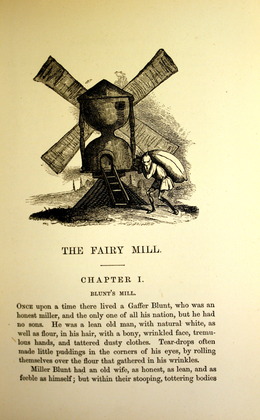Christianity and Moral Didacticism
Morley’s ‘The Fairy Mill’ acts as an exposition of the author’s support of the Cooperative Movement, which sought to challenge capitalist hegemony by unionising independent retailers. The characters with which the reader sympathises are Gaffer and Gammer Blunt, proprietors of the titular Mill. Although aged, feeble and destitute they retain ‘hearts as young and beautiful as [their] child’ (p.78), their only daughter Althy. The parents sacrifice much for their daughter, starving so she can eat and freezing she may have extra blankets, and their selflessness and honest nature are rewarded one night by the fairy Twinkle. The touchstone of their mill is charmed to grind only that which is counterfeit, inferior and artificial to dust, and thus draws the attention of the King of Flavilla; the monarch decrees that the veracity of all his attendants, parliamentary legislature and product of industry be ascertained by being passed through the Fairy Mill: ‘The regeneration of the state! Grist to the mill!’ (p.84). All prove to be false, and the moral proves to be twofold.
Morley’s Fairy Mill, which destroys any superficial or spurious objects that pass through it, is in direct contrast to the English mills and factories engendered by the Industrial Revolution. Morley believed the produce of capitalist labour to be soulless and without standards, and by reducing Flavilla’s goods to powder instead of creating them, the Mill represents the ideals and virtues of the Cooperative Movement. Once the Fairy Mill has proved to the King that what capitalist Flavilla produces is without worth, the modes of production are changed and ultimately the ‘city, honestly built, did flourish, for the test of truth was applied without fear to all the fruit of man’s labour’ (p.95). ‘The Fairy Mill’ is thus an advocacy of honest, democratically controlled enterprise opposed to the mechanised monopolies of mass-industry.












